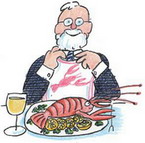![]()

Introduction, and a bit of history
Over the years, cassoulet has become a dish with which I particularly identify. Like bouillabaisse, it’s a peasant dish whose evolution embodies the anomalies that arise when such a humble tradition is subjected to gastrosnob gentrification. In the south of France, conflicting traditions have given rise to vigorous regional controversy: Castelnaudary, Toulouse and Carcassonne all claim that they invented it. Prosper Montagné, compiler of the first Larousse Gastronomique, came up with a metaphysical solution worthy of the Nicene Council. He reinvented the Holy Trinity, suggesting that there were three equal cassoulets—the Father (Castelnaudary), the Son ( Carcassonne), and the Holy Spirit ( Toulouse).
Waverley Root, I suspect, got it about right. He suggested that it all began in a continuously simmering cassole on the back of the stove, “serving as a sort of catch-all for anything edible that the cook might toss into the pot”. In the modern tradition, he found that the lowest common denominator was “a dish of white beans…cooked in a pot with some sort of pork and sausage. After that it is a case of fielder’s choice.”
This is borne out by Anatole France’s claim that the cassoulet at his favorite restaurant had been bubbling away for twenty years. My father once encountered a similar phenomenon. Almost a century ago in Kentucky, as a circuit-riding preacher, he was served a delicious soup by one of his parishioners. When he asked her for the recipe, she threw up her hands and exclaimed, “Lor’! There ain’t no recipe for soup! It jes’ accumulates!” These days, only Aga owners can easily take such a long view.
Some suggest that cassoulet derives from the Jewish cholent, set cooking in advance to eat on the Sabbath. Modern culinary practice is indeed reminiscent of the observation that it only takes one Talmudic scholar to start an argument; if you go into an isolated Languedoc village and ask fifty housewives how to make a cassoulet, you will get at least fifty-one recipes.
Or sometimes only one tradition and one cook. In Wales a few months ago, Elizabeth Luard told me about the Languedoc village where her children grew up, in which no one made their own cassoulet, but took their cassoles to a woman who was generally acknowledged to be the best cassoulet maker in the village. In the words of Elizabeth’s wonderful _Classic French Cooking_:
The Escrieux family, subsistence farmers with the right to operate their own still, potted their own confit, grew their own beans...and kept and slaughtered their own pig. No woman, she told me, ever claimed to make her own cassoulet, but boasted that it came from Madame Escrieux.
Or consider Samuel Chamberlain on Lyonnais bouchon owner La Mère Fillioux:
Her secret was disarmingly simple: Instead of preparing a great many dishes, concentrate on a very few and do them to perfection, day in and day out. Her reasoning was logical. “It takes years of study and experience to produce a perfect dish. I have spent my life perfecting five or six dishes. I will serve only these, but I will be sure of doing them perfectly.”
Such people did not learn out of books, but by rote and repetition. Our literate society has inevitably become a superficial society. We are able to swat everything up instantaneously: compared with the days of apprenticeship, every modern home cook, however expert, is merely a practitioner of fast food. We may know a lot more than we did, but most of us don't know it as well.
Not that I would like to go back to such a cultural climate. The endless predictable repetition would send me screaming over the nearest cliff. Perhaps the Gadarene swine were simply modernists before their time.
For further reflections on cassoulet, gluttons for punishment may go to Bouillabaisse, Cassoulet... on my website. Later today I’ll take you for a short trip to the Borough Market, where on Friday I picked up the essential ingredients for next Sunday’s modest little peasant feast.